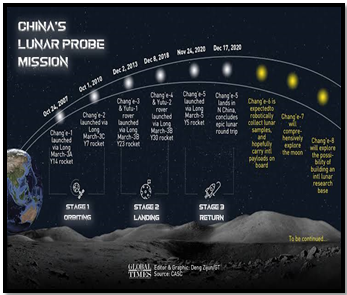CHINA’S CHANG E 5 MISSION FINDS WATER MOLECULES
Why in the news?
- Chinese scientists found water molecules in lunar soil samples from the Chang’e-5 mission, as reported by the Chinese Academy of Science (CAS).
- The research, conducted by the Beijing National Laboratory for Condensed Matter Physics and the Institute of Physics of CAS, was published in Nature Astronomy on July 16.
Source: Global Times
Details of the Discovery
- Scientists discovered a hydrated mineral “enriched” with molecular water in lunar soil samples returned by the Chang’e-5 mission in 2020.
- Researchers isolated over 1,000 mineral clasts and identified a plate-like transparent crystal called “unknown lunar mineral” (ULM-1) containing water molecules.
Historical Context and Significance
- In 2009, India’s Chandrayaan-1 spacecraft detected hydrated minerals in sunlit areas of the moon using NASA’s Moon Mineralogy Mapper (M3).
- NASA confirmed the presence of water on the moon’s sunlit surface in 2020 using data from the Stratospheric Observatory for Infrared Astronomy.
| Major Lunar Programs Around the World
1. Apollo Program (NASA, USA) The Apollo program, conducted by NASA, was the most significant lunar program, resulting in six successful manned moon landings from 1969 to 1972. Key missions include:
2. Chandrayaan Program (ISRO, India) India’s lunar exploration program aims to explore and study the moon’s surface and composition.
3. Chang’e Program (CNSA, China) China’s series of lunar missions focus on robotic exploration, sample return, and laying groundwork for future manned missions.
Associated Article: |




